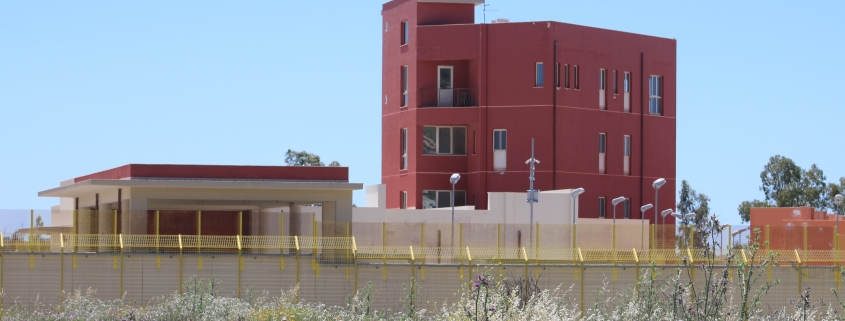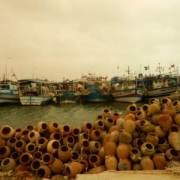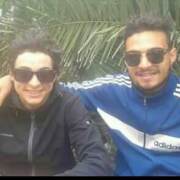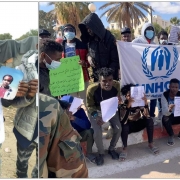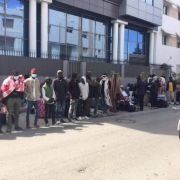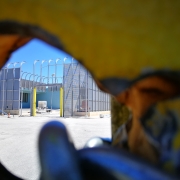The dress of detention of Tunisian migrants
Article first published on march 22, 2022
Tunisian citizens make up the majority of migrants who are detained and repatriated. They are systematically criminalised and subjected to violation of rights. The stories and bodies of Sami, Wissem, Akram and Bilel tell us this.
Migrants of Tunisian origin are the ones who are most affected by institutional racism and by the increasing militarisation of the Mediterranean border. In particular, since the summer of 2020, following an increase in the number of Tunisian arrivals on the Sicilian coast, Italy has set up a highly efficient machine for rejections. Under the agreement between the two countries, Italy has committed to finance € 8 million to restore six patrol boats in possession of the Tunisian Coast Guard in exchange for Tunisia’s commitment to strengthen border controls and train security forces to patrol the coast. In addition, it was agreed to resume repatriation flights of Tunisians – suspended during the first months of the pandemic – with pre-established weekly quotas of citizens to be expelled through 2 charter flights (up to 3) per week. On the basis of this agreement, the expulsion orders against Tunisians have therefore increased, and between November 2020 and January 2021 they constituted 80.5 % of foreign citizens transited through the Detention and repatriation center (CPR) and 75.5 % of foreign citizens repatriated from Italy, according to data released by ASGI.
The socio-economic instability and the political crisis are factors that are pushing thousands of Tunisian citizens – men, women and many UAM* (Unaccompanied foreign minors) – to leave their country of origin: according to UNHCR, during 2021, Tunisian migrants who reached the Sicilian coasts were about 15,671, the majority of total arrivals. But because of these agreements, only a fraction of these people had access to the possibility of requesting international protection: considered a priori “economic migrants” and using only the criterion of nationality, Tunisians almost automatically enter into expulsion and repatriation procedures – in violation of the Geneva Convention – and face violence of various kinds.
Detention and repatriation: the perfect machine
From what has been observed, the procedures for the forced repatriation of Tunisian citizens in times of pandemic are carried out in 3 steps:
Hotspot. Normally, Tunisian migrants land on the coasts of Lampedusa or Pantelleria. As far as Lampedusa is concerned, migrants are taken to the Contrada Imbriacola hotspot where a pre-identification procedure is carried out, in which the filling in of the news sheet, photo-signalling and fingerprinting take place. From what has been observed, the public security authorities apply an essentially automatic selection based on the country of origin of the individual and no correct legal information is provided. In fact, Tunisian citizens are excluded almost a priori from international protection and can be repatriated through an accelerated procedure. For migrants arriving in Pantelleria, the pre-identification procedure seems to take place in the first reception centre of Pantelleria and the identification is completed in the CPR* of Trapani Milo, where there are the offices of the Questura*.
Quarantine ship. From the identification they move to the confinement in the quarantine ship for the isolation period provided for the prevention of Covid-19 infection. From what has been observed, more than a sanitary device, the quarantine ship turns out to be the antechamber of the repatriation where to complete the legal channelling phase of the hotspot procedure: the time spent in the ship serves to complete the selection of foreign citizens, distinguishing between “asylum seekers” and “economic migrants”, between those who have access to reception and those who are expelled, in order to determine the legal paths and simplify the repatriation procedures.
Removal – expulsion. After disembarkation from the quarantine ships, the migrants fill in a second news sheet and here the process leading to the expulsion of Tunisians is completed. This procedure is carried out once again without access to information, without having the opportunity to tell their personal story, without allowing people to express their request for international protection, without the possibility of explaining other situations that would prevent repatriation (family reunification or other). Irregular foreign citizens who cannot stay in the Italian territory are subject to a removal order from the territory: this may entail the detention of the migrants in the CPR* or an order to leave the Italian territory within 7 days. With the identification by the Tunisian consular authority at Palermo airport, the final execution of the repatriation of the Tunisian citizen is allowed.
Thus, in these few steps a Tunisian migrant is sent back to his country of origin without any guarantee to protect his rights. Even the possibility of challenging a removal order before a judge is not always effective: often the appeal has no effect on the suspension of the enforcement of the return and the right to defence is further hindered once the migrant is confined in the CPR*. Moreover, in recent months, the procedure has been greatly accelerated and the return may take place within days of arrival in the centre. Restrictions related to Covid-19, limited access to the CPR* for lawyers, NGOs, the outside world and the confiscation of detainees’ mobile phones further hinder the effective exercise of rights and almost always Tunisian citizens are returned without having had a legal interview. However, this has not hindered the creation of informal forms of communication between detainees and legal support networks, through the efforts of family members and associations – above all the In Limine Project and the LasciateCIEntrare Campaign – thanks to which many migrants have been freed from unlawful detention.
Indeed, the experience of alienation and deprivation of freedom that migrants have to endure is inseparable from the struggles for the recognition of their rights. The forms of rebellion and protest, from the hotspot to the quarantine ship to the CPR*, have multiplied. From self-harm practices, to appeals on social networks, to demonstrations, migrants, particularly Tunisians, make their bodies – detained, humiliated and mistreated – a field of struggle.
Sami, Wissem, Bilel
Among the many stories is that of Sami, a Tunisian man detained in the last two months in the CPR* of Trapani-Milo, one of the two CPR* located in Sicily, together with the one of Pian Del Lago in Caltanissetta. During his time in the Sicilian detention facility, Sami repeatedly self-harmed, stitching his eyelids, lips and genitals. Sami was detained for two months and underwent several psychiatric hospitalizations during the weeks, the last one happened a few days before the presidium of March 12, 2022, called by several anti-racist groups in front of the CPR*. It was precisely on that occasion that it was possible to bring this story to light. His case is not an isolated one: it is just one of those that have emerged from the grey area concealing the practices implemented in places such as the CPR*, where irregular migrants are subjected to administrative detention and deprivation of liberty even though they have not committed any crime.
After threats to hang himself if his release was not arranged, on March 14, with the issuance of a decree not to extend his detention, Sami finally left the CPR*, free to join his family in Europe.
Wissem Ben Abdel Latif did not have the same fate: a young 26-year-old Tunisian man from Kebili, who died in November 2021 in psychiatric restraint at the San Camillo hospital in Rome, sedated and tied hand and foot to a hospital bed, after having passed through the Ponte Galeria CPR*, where he was detained despite the suspension of his detention ordered by the Justice of the Peace. Although he did everything he could to get out of that detention, Wissem found death in the hands of the institutions. His death cannot be dismissed and this is why the Truth and Justice Committee for Wissem Abdel Latif was set up, promoted by the young man’s family, the LasciateCIEntrare Campaign, the Franca and Franco Basaglia Foundation and the Sergio Piro Association.
Another violent death was the one of Bilel Ben Masoud, a 20-year-old Tunisian from Sfax, who died in May 2020 during his confinement on the quarantine ship Moby Zaza, off Porto Empedocle, while in quarantine. Bilel wanted freedom and attempted to cross the sea to reach the Sicilian coast. He was the first – and not the last – person to lose his life while detained on a quarantine ship, another of the infrastructures that the state has put in place to confine migrants, deprive them of their personal freedom and effectively facilitate their deportation.
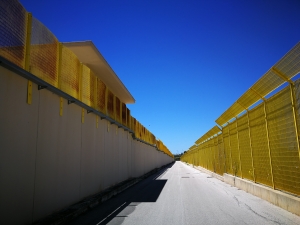
The CPR* of Trapani Milo – Photo by Silvia Di Meo
Resisting Bodies
Therefore, the invisibility and abandonment of migrants to suffering and death – typical of migratory necropolitics – do not prevent resistance practices through the incorporation of violence by those same imprisoned bodies. This is also demonstrated by the numerous stories of migrants in detention told by Francesca Esposito, Emilio Caja and Giacomo Mattiello in their edited volume “Corpi reclusi in attesa di espulsione. La detenzione amministrativa in Europa al tempo della sindemia“: bodies resist violence against migrants, even when attempts are made to remove their stories.
Among the bodies whose stories one attempts to erase is that of Akram Taamallah: a Tunisian from Menzel Bourguiba, who died in a shipwreck in November 2019, buried in the cemetery of Cefalù. A “discarded life”, whose existence was denied and that is not even allowed to mourn: one body among many that neither the Tunisian nor the Italian state want to take charge of to bring him back to Tunisia among his loved ones. Akram’s case shows how we treat migrants, the lives we consider disposable, not only when they are alive, but also when they are dead: if when they are alive migrants are bodies on which domination and oppression are exercised, swallowed up by the machine of containment and rejection, when they are dead they no longer have any value and in these cases repatriation – which would entail the recognition of political responsibility – becomes an individual burden of the families to whom the state shows indifference. However, those bodies continue to be political bodies that claim and demand justice, through the voices of other people, family members and activists. Thus, the stitching on Sami’s body, the ligature marks of Wissem’s and Akram’s remains buried in Sicily, resist the historical removal of that violence.
This is not all: in times of war where the double morality that determines the hierarchy of lives dominates, these bodies are the emblematic testimony of the selective racism of the European border applied to those who exercise the right to escape, which classifies who is “worthy” of reception and who is not entitled to freedom of movement, which identifies the lives “worthy” of being protected and those to be left to die without any mourning.
The dress of detention and all the other dresses
During the presentation event of the Truth and Justice Committee for Wissem Ben Abdel Latif, Yasmine Accardo, of the LasciateCIEntrare Campaign, said: “Wissem was forced to wear the dress of detention from beginning to end”. In fact, from his arrival at the hotspot to the quarantine ship to the CPR* to the psychiatric ward until his death, Wissem wore the same clothes: he was prevented from changing, he was abandoned to dehumanisation and brutalisation until his death.
Detention is the dress the state sews on migrants who are criminalised from the start: not only on Wissem, but on all people who experience the same discriminatory treatment. Tunisians above all, defined as “economic migrants”, the irregular immigrants par excellence, the “criminals”, those who have no rights, on whom forced return, imprisonment, humiliation and violence are systematically imposed.
Listening to Yasmine’s words and mentally visualising “the dress of detention” she was talking about, I was immediately reminded of other Wissem dresses I had seen in Kebili, the young man’s home town, where his mother Henda and sister Rania hosted me when I visited them in December 2021. On the day of my visit, in Wissem’s room – after long speeches about detention and suffering – the two women had taken his clothes out of the wardrobe and stacked them before my eyes: clothes for sports, for going out with friends, for work, hats, shoes. This exhibition was meant to show Wissem’s material life, in all its facets, as if to say: all this was Wissem, let’s not forget it. The selected and discarded body, clad in the garb of imprisonment and restraint, is a body that fought for its freedom. The wallet on the coffee table, the made-up bed, the stories of his sisters: this was Wissem, not a migrant to be deported, but a young man who had plans, whose life is still there pulsating within those walls.
Today, Rania and Henda are fighting in the Truth and Justice Committee for Wissem Ben Abdel Latif, with associations, lawyers, but also with all the other Tunisian mothers and sisters who are searching for their children who have disappeared or died in the Mediterranean, to whom the violence of the border has inflicted the same wounds, more or less lethal.
With the other Tunisian women, Henda and Rania embroider sheets with the face and story of Wissem and all the others who wore the “clothes of detention”: young people stranded at sea before arriving, young people who were shipwrecked, who were repatriated, who self-harmed, who perhaps eventually escaped from quarantine ships and CPRs*, carrying with them the indelible marks of that struggle.
All the clothes, photos and sheets embroidered with names and stories are objects that we have the duty to exhibit: they are the symbols that oppose the “detention dress” that Tunisians and criminalised migrants want to wear. They are the signs of existences that cannot be reduced to discarded and expelled lives. They are the indelible memory that reminds us: migrating is not a crime. Humiliating, raping and killing is.
Silvia Di Meo
Borderline Sicilia
*CPR (Centro di permanenza per il rimpatrio) – Detention and repatriation center
*UAM – Unaccompanied foreign minors
*Questura – offices responsible for police force, public order and relative administrative services
Translated from Italian by Cristina Tosone

